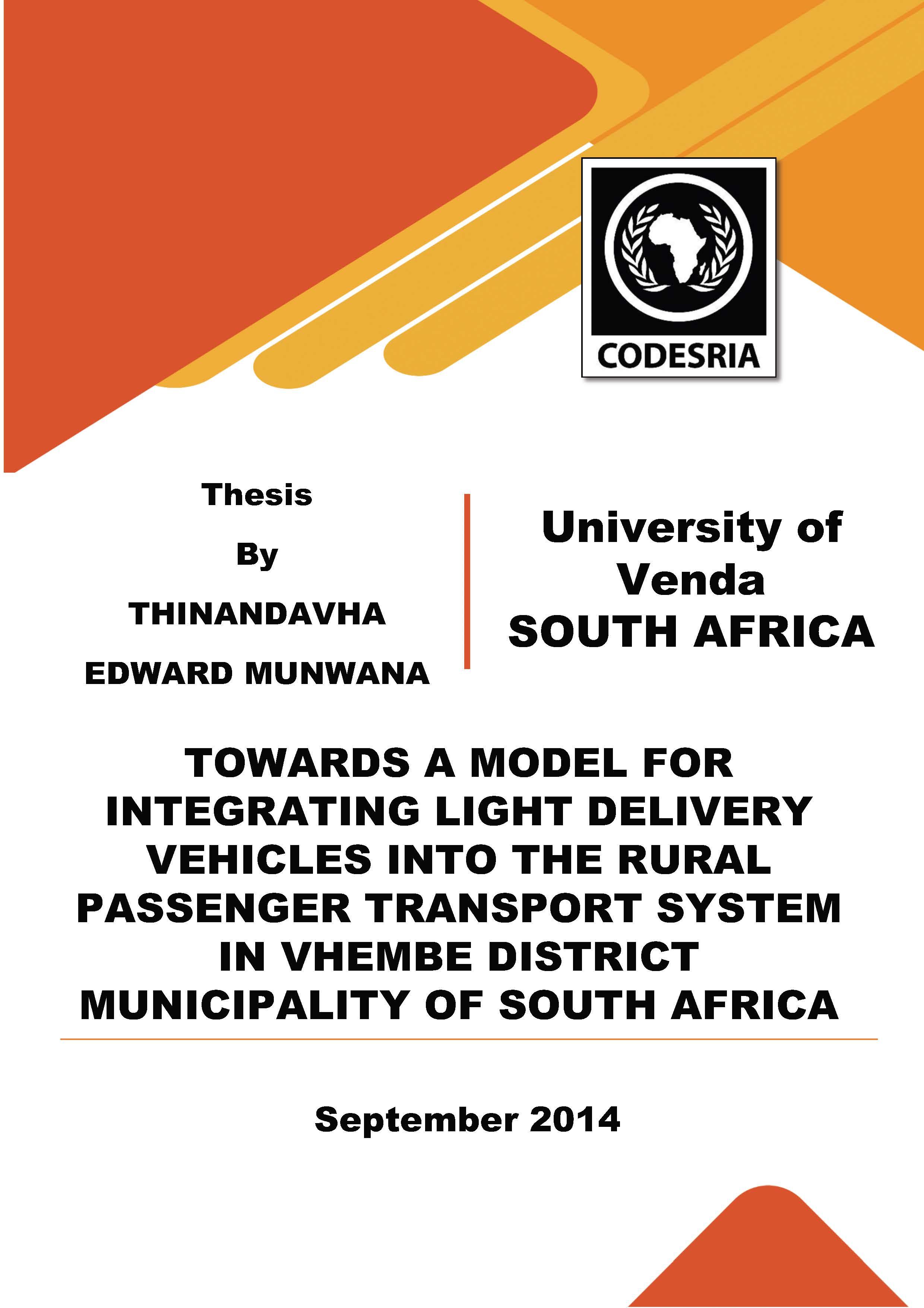TOWARDS A MODEL FOR INTEGRATING LIGHT DELIVERY VEHICLES INTO THE RURAL PASSENGER TRANSPORT SYSTEM IN VHEMBE DISTRICT MUNICIPALITY OF SOUTH AFRICA
Mots-clés :
Light delivery vehicles, rural passenger transport, framework, integrating, modelSynopsis
This study originated from the premise that Light Delivery Vehicle (LDV) passenger transport is a vital but not necessarily safe mode in rural communities such as those in Vhembe District of Limpopo Province, South Africa. Moreover, the lack of detailed scientific data and as yet illegal status of the service inhibit efforts being made to strengthen it. The aim of this study was to
suggest a framework for a model for integrating LDV passenger transport into the public transport system in Vhembe District. It was assumed that LDVs could be a suitable mode of rural passenger transport if appropriately modified and a supporting legislative framework introduced. The nature and extent of the LDV service within the wider transport context in Vhembe District were investigated. A mixed methods approach was adopted, based on focus group discussions, in-depth interviews, observations and questionnaire was used. For the questionnaire study, the purposively sampled research participants comprised 100 LDV operators, 100 commuters and 69 Administrators). The snowball technique and knowledge of the respondents regarding LDV passenger transport were applied.
The use and operation of LDV passenger transport was found to be an established, regular, demand-driven, sustainable and expanding reality, operating alongside other transport services, especially in remote rural areas. A strong relationship (P < 0.05) existed between the reasons given for using LDVs and the municipalities where the respondents resided. The transport service was affordable and flexible, although it was not necessarily comfortable or safe. There was a strong statistical relationship (P < 0.01) between the level of satisfaction with other transport services and municipalities in which they resided.
Although the informal nature of LDV transport provided some short-term advantages to operators, various stakeholders including operators of LDV transport indicated that the formalization of the service would lead to long-term advantages such as improved service delivery, operational efficiency and an increased customer base. The LDV transport operators were prepared to comply with structural and other changes the regulatory authorities demanded, and indicated a distinct readiness to work alongside existing public transport services.
Using the study’s findings and available literature a procedure or model for integrating LDV passenger transport with the public transport system in Vhembe District was developed. What are its main features? However, there is need for further studies that examine whether the proposed model for the modification and integration of LDV passenger transport is feasible and plausible beyond Vhembe District. There is need for policy and legislative reforms that allow use of LDVs as passenger-carrying vehicles, which entails insistence on fitting canopies, spelling out seating capacity, proper seats, issuing route permits and other safety-related measures specified by the South African Bureau of Standard (SABS) and Occupational Health Standards (OHS).
Téléchargements
Références
Adeoti, J.S. (2009).The potential and development in animal transport devices. llorin, Nigeria: University of llorin.
AFRICAN UNION. (2005). Declaration of the African Transport Ministers responsible for Transport and Infrastructure on Transport on the Millennium Development Goals (MDG). Addis Ababa, Ethiopia: African Union.
AFRICAN UNION AND UNITED NATIONS ECONOMIC COMMISSION FOR AFRICA. (2005). Transport and the millennium development goals in Africa. Addis Ababa: African Union.
AFRITEST. (2012). Background information on transport issues in South Africa. York: Stockholm Environment Institute (SEI), University of York. http://www.afritest.net/index.php/country-status-65. Accessed on 8.02.2013.
AGRAN, P., WINN, D. AND ANDERSON, C. (1994). Injury to occupants in cargo areas of pickup trucks. Journal on Traffic Safety. 161(5): 479-481.
ARCHER, E.K., CHANDE, R., DARKOL, M.B.K. AND MPOTOKWANE, M.A. (2005). Road improvement and safety. Case studies for the western region of Botswana. Proceedings of the 24th South African Transport Conference (SATC), 11-13 July 2005. Pretoria: South Africa.
ARRIVE ALIVE, 2012. Arrive Alive Road Safety Campaign. http://www.arrivealive.co.za. Accessed on 31.08.2012
ASIAN DEVELOPMENT BANK. (2006). Sustainable Rural Transport Services in the People’s Republic of China (PRC). Technical assistance report, project 36459. Manila, Philippines: Asian Development Bank.
BABBIE, E.R., AND MOUTON, J. (2001). The practice of social research. Belmont: California: Wadsworth.
BABBIE, E.R. (1973). Survey research methods. Belmont, California: Wadsworth.
BABBIE, E.R. (1992). Survey research methods. Belmont, California: Wadsworth.
BAILEY, K. (1994).Methods of social research.4th Ed. New York. The Free Press.
BANJO, G., GORDON, H. AND RIVERSON, J. 2012. Rural transport. Improving is contribution to growth and poverty reduction in Sub-Saharan Africa. Sub-Saharan Africa Transport Policy Program (SSATP), Working Paper 93. Washington: The International Bank for Reconstruction and Development/World Bank.






